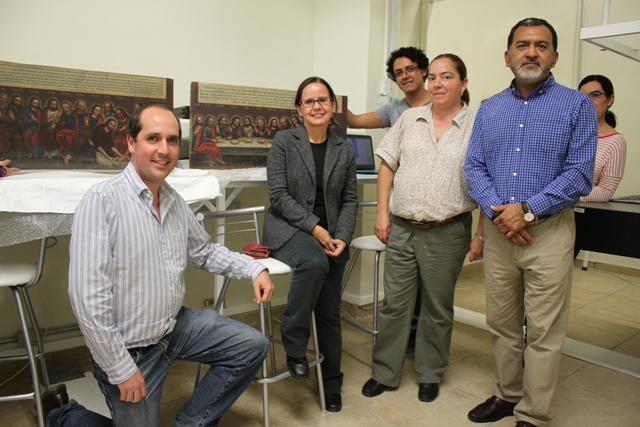Jan 5 2015
A multidisciplinary research team leaded by specialists of the Center for Research in Optics (CIO) unveiled that in two paintings in the side altar of the parish of Our Lady of the Immaculate Conception in Purisima del Rincon, Guanajuato in center Mexico, by artist Hermenegildo Bustos, three layers with a number of unregistered modifications were identified and which the naked eye can not see.
 The multidisciplinary team, form left to right: Enrique Castro Camus of the CIO; Mirta Isaurralde Caballero, director of the Laboratory of Analysis and Diagnostics of Cultural Heritage (LADIPA) of the College of Michoacán; Diego Iván Quintero Balbás, researcher at LADIPA; Carolusa González Tirado, director of INAH Guanajuato, and Elder de la Rosa, head of CIO.
The multidisciplinary team, form left to right: Enrique Castro Camus of the CIO; Mirta Isaurralde Caballero, director of the Laboratory of Analysis and Diagnostics of Cultural Heritage (LADIPA) of the College of Michoacán; Diego Iván Quintero Balbás, researcher at LADIPA; Carolusa González Tirado, director of INAH Guanajuato, and Elder de la Rosa, head of CIO.
These pictures were originally painted in the first half of the eighteenth century and retouched in the early nineteenth and in 1903. For a month, CIO specialists worked with a terahertz spectroscopy technique through which they discovered "hidden images" of the work, rebuilt several details and objects that were in previous layers that are now invisible.
Enrique Castro Camus from CIO, explains that by using this technique they managed to see the original images and retouching done in 1816 and 1903. In the first there are chandeliers and curtains that Hermenegildo Busto decided to remove in 1903.
"What we do is send a short pulse of light that reaches the surface of the work; part of the light is reflected there and successively on each layer of paint. Then, we detect the pulse return, we seek the echoes and reconstruct what is in the inner layers".
He adds that the technique is applied point-by-point and recovered layer by layer using software designed by the student Arturo Hernández.
According to the specialist, this technique is of far infrared light or "terahertz light" -a type of light between the infrared and microwave, with which is possible to reconstruct thin layers of paint-.
Castro Camus notes that during the month the team had access to the two original paints, they studied them and according to the analysis of data obtained conclude that by the terahertz spectroscopy technique they can reconstruct hidden layers and identify what elements have been changed or painted over.
A little bit of history
The idea of analyzing the pictures of the altarpiece of the Purisima del Rincon in Guanajuato by Hermenegildo Bustos was of a student at the School of Conservation and Restoration of the West in Guadalajara, Montserrat Gómez, a graduate of the Bachelor of Restoration of Movable Property and decided to make her thesis at the CIO.
She contacted her university, the College of Michoacán and the National Institute of Anthropology and History (INAH) of Guanajuato; and raised the idea of analyzing the pictures with this technique, since according to the very brief historical record, it was retouched several times.
After performing the bureaucratic procedures, INAH lent the researchers the two paintings, and they were taken to the CIO laboratory.
"After analyzing we generated images of the hidden layers of paint, using a terahertz spectroscopy technique and achieving to reconstruct many details and objects that were in the previous layers, and which are not visible in the latest version."
With this technique, the researchers showed that they have the ability to make a three-dimensional reconstruction of each one of the layers of paint behind the same work and, moreover, obtain data of interest to historians and those working in the art conservation sector.
With this previous result -points Castro Camus-, we can offer this tool to INAH researchers or specialists in the area of cultural heritage and art conservation.
“Combining science and other disciplines can yield interesting results; besides the cultural area, we can apply the technique in biomedicine, solar cells and semiconductors," concludes the specialist at CIO. (Agencia ID)